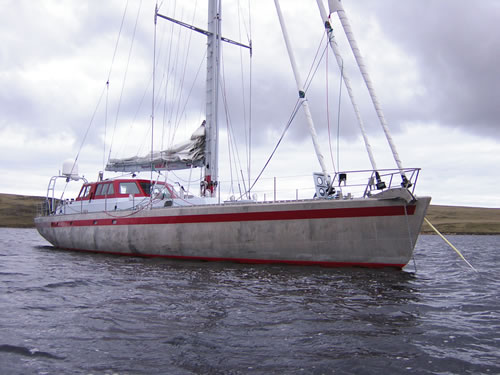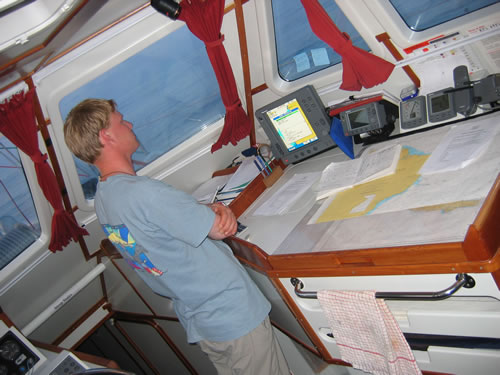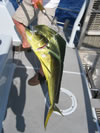The Delivery North on Pelagic Australis
Introduction
Arguably, Skip Novak’s new high latitude polar expedition sailing vessel, Pelagic Australis, has opened up some of the most “hands on” RYA Yachtmaster training available on the planet.

The Tony Castro/Novak designed 74 foot aluminium hulled cutter left from the frigid shores of southern Chile on April 21 of this year after completing her first successful season of Antarctic expeditions. The destination was Southampton, home of the RYA, and the passage was advertised as a 7000 mile ”delivery” with the chance not only to gain more than the required sea miles (by a factor of nearly 4) while studying the yachtmaster syllabus en route.
The six trainees ranged from a 19 year old Gap Year student to a 73 year old retired surgeon, and the goal for them was to master the true ‘working end’ skills required to be a yachtmaster and to negotiate ocean passages. It proved to be a whirl wind tour of the Atlantic that they will not forget.
Australian skipper of Pelagic Australis ( PA ), Stephen Wilkins, who is a RYA Yachtmaster Ocean examiner and lecturer at the Australian Maritime College, gives an insight to the training voyage which saw them cover just under 8,000 nautical miles “through the water’ in 43 days during their north/south transit of the Atlantic Ocean.
Steve's Account
Sailing on this type of vessel can be a little daunting for those who haven’t had big boat experience, so a minimum of two days training was spent at the dock in Chile to ensure that everyone was familiar with the way the vessel was set up, that they knew how the systems worked and that they were comfortable with the operation of the safety equipment. Full rig checks, engine servicing, provisioning, passage planning and even a team building session made the days long and the learning curve high, but the satisfaction of getting to know Pelagic Australis, as well as everyone onboard was rewarding.
Navigation and weather analysis was obviously a big focus for the voyage. The navigation/weather gathering technology onboard includes GPS, radar, Inmarsat Fleet 77, SatCom C, HF weather fax and the latest technology in direct satellite weather retrieval systems and GRIB file viewers.
On the seamanship side, skills taught included rope work and splicing, sail handling, helming and heavy weather tactics. Engine maintenance was touched on as was servicing deck gear en route. Of course, cooking at seas, not always an easy task was fundamental for survival of such a long passage!
From the Beagle Channel we departed on the back of a low pressure cell which delivered gusts of over 55 knots making for exhilarating broad reach sailing as we blasted our way through the infamous Straits of Le Maire. During the following days while running up the coast of Argentina we consistently achieved 200 nautical mile days, which kept everyone on their toes.
Life onboard quickly slipped into the structure of a well organised training run as the miles clicked by. Daily routine comprised of morning and afternoon tuition sessions with both watches. Each day I would create a daily nautical case scenario which the entire team would debate at dinner time, many of these cases featuring “Baz,” a hypothetical numpty who could never do anything right, or if a disaster was going to happen then he was a magnet ! Laughs and heated debate were guaranteed.

Each person took on the role of watch captain rotating for one week at a time on their respective watches under the careful eye of myself and the two onboard crew, Alec and Jane, who had been working the season down south, ensuring that all theory being taught, from practical to people management skills, could be practiced in real life. A long passage like this must be well managed and there are always going to be moments where heated discussions and personal issues flare up. To recognise and be able to manage a team is such an important part of taking command.
Fun and sun! Intertwined with the testing, teaching and practice of collision regs, flags, and rules of the road were many memorable days of glistening seas, dolphins, turtles, breath taking sun rises and moon lit waters.
Training must be made enjoyable for maximum impact, so throwing the fishing line over for some fresh ocean produce delivered regular delights, Tuna and Dorado featured highly and even a Barracuda was landed keeping the meals full of variety and ensured that we didn’t have to open any of the dreaded emergency rations of tinned “spicy meat balls”.
Food is always a major focal point for long passages and Pelagic Australis is set up with a gourmet galley and extensive provisioning so that anyone with even basic culinary skills is soon whipping up fresh muffins, risottos, fresh bread, roasts and quiches to whet the appetites of the hard working team.
Days and miles soon drifted buy at a surprisingly fast rate. Pelagic Australis being a expedition vessel meant that the thirst for unchartered waters and locations took the team to the extinct volcanic island of Trindade, located at 20° 30´ South, 29° 18´ West who’s northern rocky crag cliff faces look like something out of Star Wars. Progress north meant that our track was so close to the famous Rocks of St Paul, just north of the equator at 00° 55´, that a short detour and circumnavigation of this tiny rocky island group was a must. And of course no passage of the North Atlantic would be the same without sighting the friendly shores of the Azores and experiencing the warm hospitality of “Peter” at the Café Sport in Horta on the island of Faial.
Those last 1400 miles to the murky waters of the English Channel didn’t disappoint anyone, the sailing was superb, the evenings peaceful as we avoided getting close to the crowded lanes of the shipping channels. To see the sight of a French space rocket being launched on a perfectly clear night as we neared the western approaches of the Channel brought everyone on deck for a once-in-a-lifetime experience to remember as it visibly blasted its was through the upper atmosphere leaving trails of glowing particles in its wake like phosphorescence trails from our yacht.
Truly great ocean voyages are still possible and it’s a pleasure to see such competent people, as we had on board Pelagic, reach out and take on a life challenge and succeed. Kevin Cronin, an American on board this training run, successfully passed his yachtmaster practical on arrival to the UK. All the other students are going on to pass their coastal skippers exams, but will certainly become yachtmasters in their own right as their learning and experience continues to grow.
Stephen Wilkins
Skipper, Pelagic Australis
RYA Yachtmaster Ocean Examiner
Master Class 3 STCW 95
www.pelagic.co.uk Site Homepage © Pelagic 2003. All rights reserved.






